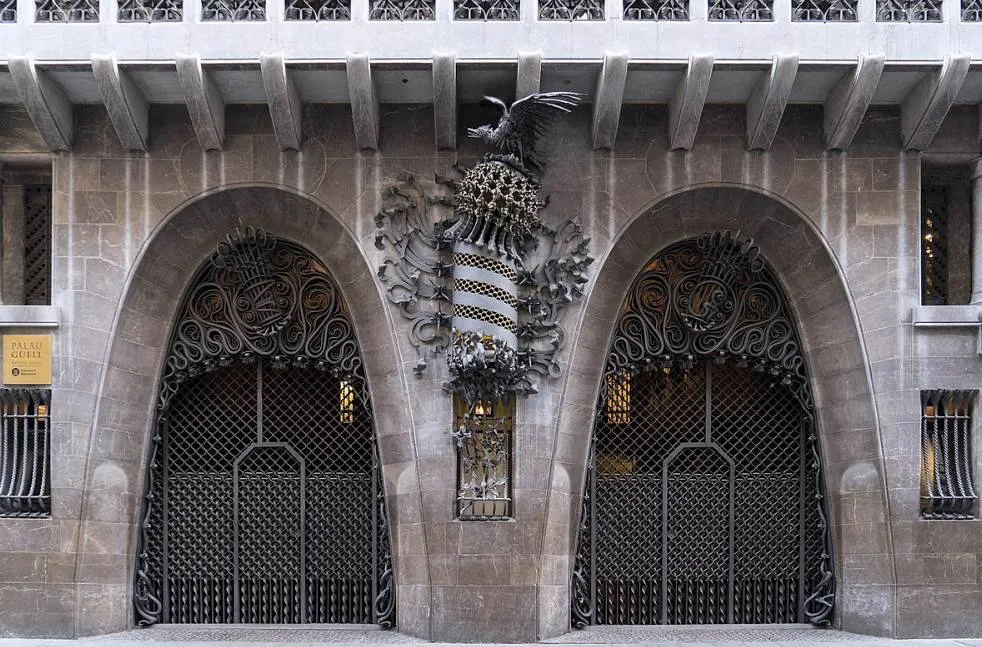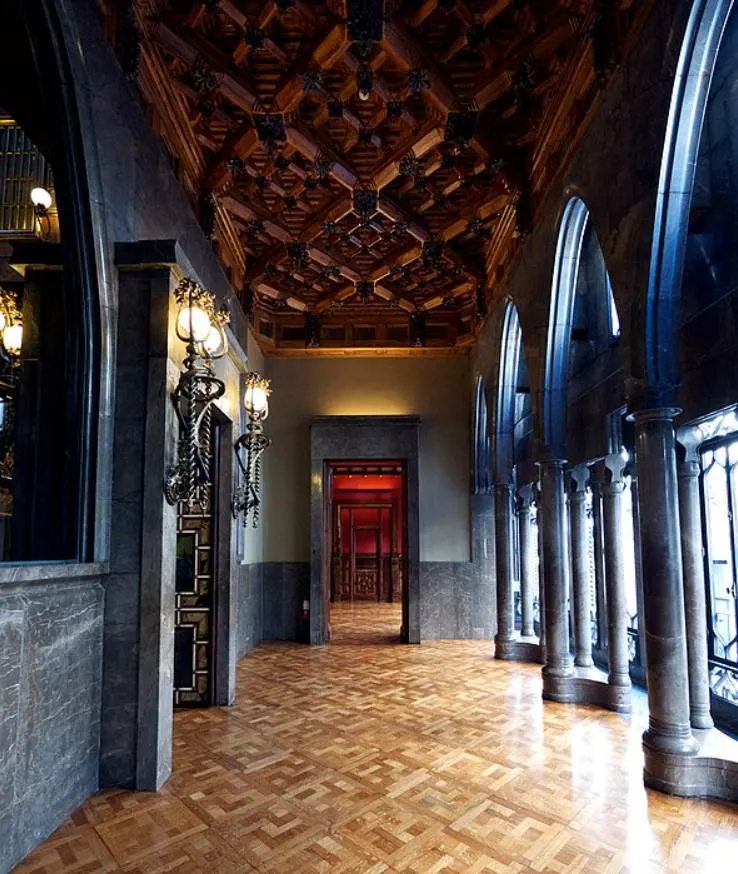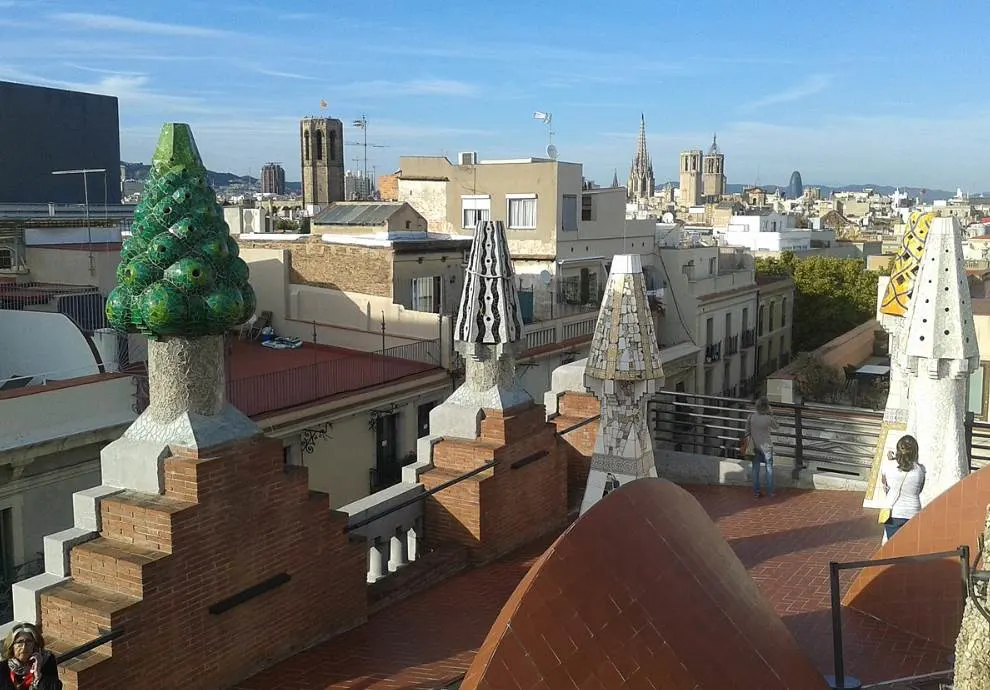Shortly after one of the most famous Spanish architects in history completed his first major project, he earned several other important commissions.
Antoni Gaudí I Cornet (1852-1926) was in his early thirties when his distinctive architectural style gained recognition.
He subsequently transformed his native city by designing some of the most amazing Art Nouveau buildings in history.
In this article, you’ll discover some of the most interesting facts about the Palau Güell, a building in Barcelona with a remarkable story to tell.
1. It’s located in a side street of Barcelona’s most famous avenue
The Palau Güell of “Güell Palace” is a large mansion designed by Antoni Gaudí in the heart of Barcelona, the capital and largest city of Catalonia.
It’s situated within the El Raval neighborhood which is part of the Citta Vella district of the city. This historic district borders the old port of Barcelona.
This means that it’s the historic heart of the city and one of just two districts that border La Rambla, the most famous street in Barcelona.
On the opposite side of this major avenue, you can find the Gothic Quarter. That’s the oldest part of the city centered around Barcelona Cathedral, the amazing Gothic Cathedral in the city.

2. It was commissioned by Gaudí’s most important patron
The mansion was named after the man who commissioned it in the mid-1880s, Eusebi Güell (1846-1918), the most notable patron of Antoni Gaudí.

Güell was born into a wealthy family as his family was an industrialist who made a fortune in the textile business. The industrial revolution in Barcelona in the late 19th century was very favorable for him as well.
While his textile factory was printing money, he discovered the unique talent of Gaudí during the Paris World Fair of 1878.
Following the success of Gaudí’s first major commission, the Casa Vincens, Güell asked the young architect to design his wine cellar known as the “Bodegas Güell.”
It was the first in a long list of collaborations between the two men. Some other notable works included the Güell Pavilions, the Park Güell, and the Colònia Güell.

3. The Palau Güell was completed in two years in the late 1880s
The rich industrialist commissioned his winery in 1882 and this was followed by several other commissions, including that of the Palau Güell in 1886.
Money wasn’t a problem so this huge mansion on the Carrer Nou de la Rambla was completed between 1886 and 1888.
The building was constructed as a party location for people of the Upper Class of Barcelona in the late 19th and early 20th centuries.

4. The mansion featured some nifty ways to welcome guests
Unlike in modern times, there were no vehicles yet so distinguished guests arrived in horse carriages.
They didn’t have to get out of the carriage on the street. Gaudí designed the entrance in such a way that the horses could just walk inside the building through the large iron gates.
The architect’s creativity didn’t stop there because, after debarking from the carriage, the horses traveled down a ramp to the basement while the guests could climb the stairs to the waiting room.
If you look closely at the ironwork above the entrance you can see the shape of a horsewhip as well.

After arriving in one of the mansion’s waiting rooms, guests could already get a glimpse of the remarkable architectural design of the interior.
There’s another reason why they were sent here, though. The ceiling and upper part of the walls featured windows which allowed the hosts to spy on their guests.
This allowed them to see who was arriving without being noticed and it also allowed them to change clothes if the occasion called for it.

6. The most amazing feature of the mansion can be found in the party room
Just like how Nero’s Domus Aurea was centered around a room that was constructed to instill a sense of awe into everyone who entered it, Gaudí designed the party room of the Palau Güell to achieve the same.
The main room of the building features a tall ceiling that has small holes. When the party was getting started, lanterns were hung just outside of it to create the illusion of a starlit sky.
Yes, this was without a doubt the most impressive nightclub in Barcelona in the late 19th century!

7. The building became a UNESCO World Heritage Site in 1984
Antoni Gaudí designed some of the most notable buildings in history, including the magnificent Sagrada Família which is about to be completed according to his plans.
Güell’s projects were plenty, but not the only important structures that he designed during his career, several of which were designated as UNESCO World Heritage sites in 1984.
The Works of Antoni Gaudí include buildings in and around Barcelona that incorporate vegetal forms, ceramics, stained glass windows, wrought iron, and other elements that made the architect’s work so famous.
Some other notable works in this list are Casa Milà and Casa Batlló, two other mansions commissioned by wealthy individuals from Barcelona in the early 20th century.

8. It was completely renovated in the 21st century and is open to visitors
Although the building appears to be very robust, some of the materials that were used for the foundations weren’t intended to stand the test of time.
The Palau Güell was crumbling by the early 21st century and had to be closed to visitors in 2004.
Mercedes, the youngest daughter of Eusebi Güell, donated the building to the City of Barcelona in 1945 and the local government initiated a renovation project that was completed in 2011.
Today, the mansion is open for visitors and the perfect place to learn more about Gaudí’s remarkable architectural achievements.

